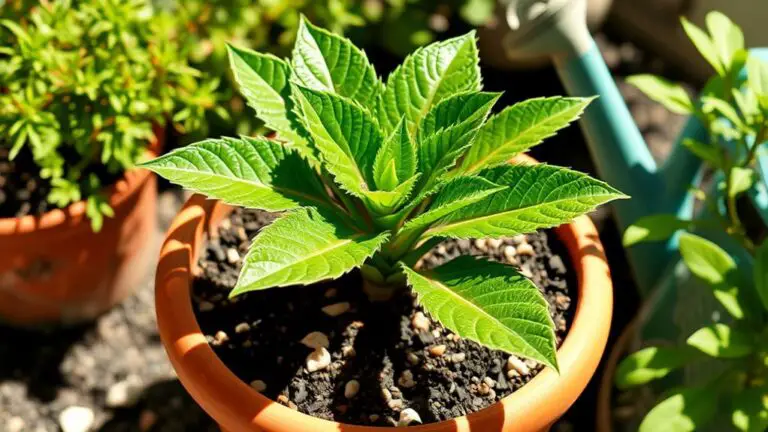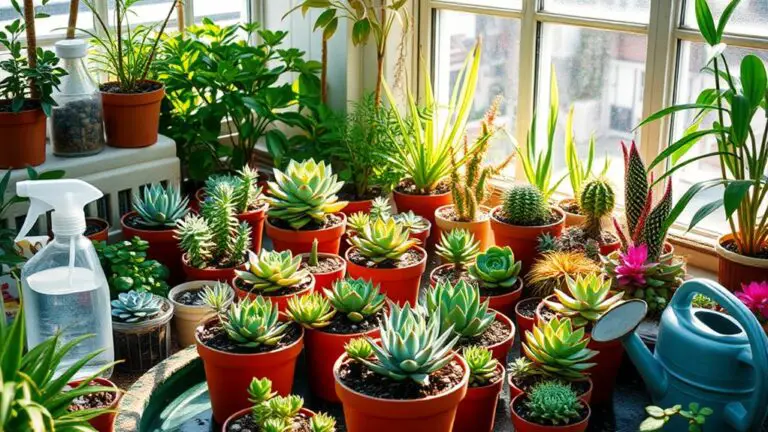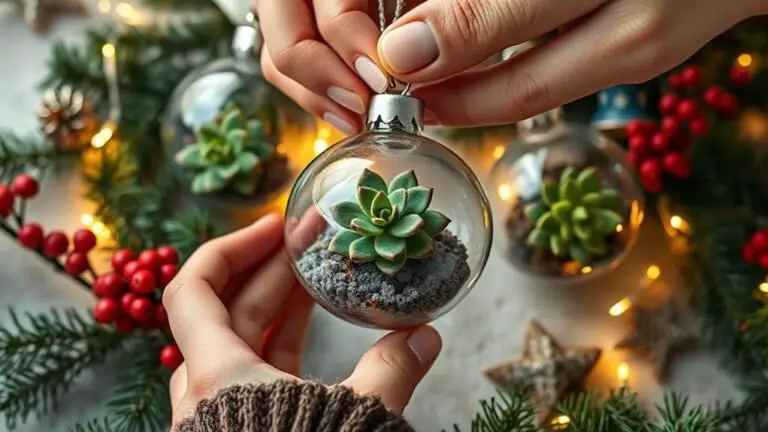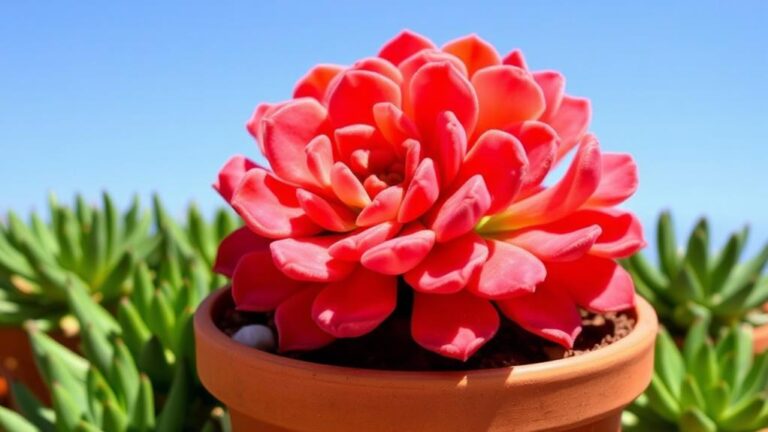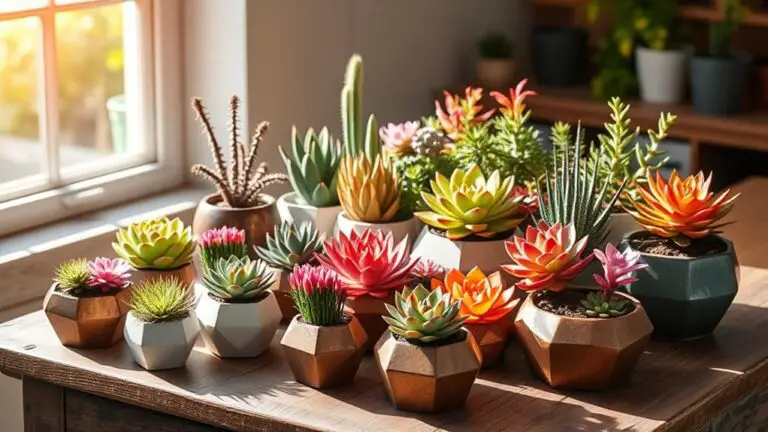Care for Your Sedeveria Blue Elf in 7 Steps
Caring for your Sedeveria Blue Elf doesn't have to be a mystery. You'll need to focus on seven essential steps that cover everything from light requirements to dealing with common problems. First, consider where you're placing your plant; it needs about six hours of bright, indirect sunlight each day. But light is just one piece of the puzzle. How you water it, the soil you use, and when to prune are all vital factors. Let's break down each step to guarantee your Sedeveria Blue Elf thrives and remains a stunning addition to your space.
Light Requirements
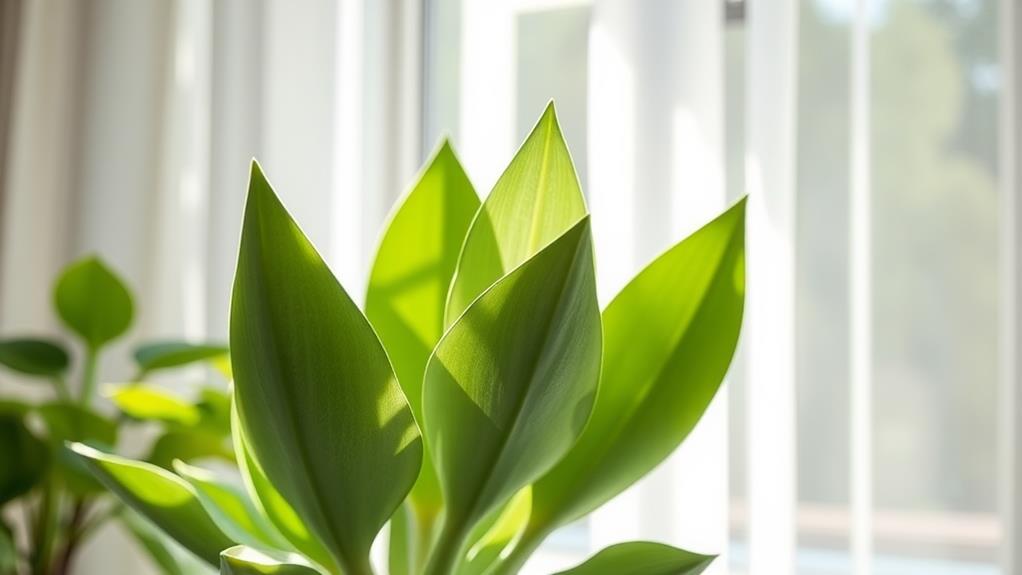
When it comes to the light requirements for Sedeveria Blue Elf, bright light is key. This succulent thrives when it receives at least 6 hours of bright, indirect sunlight each day. To achieve peak growth and bring out its vibrant hues, place your plant less than 1 foot from a south-facing window. This position guarantees it gets plenty of the light it needs.
If you notice your Sedeveria Blue Elf experiencing poor growth or wilting, low light might be the issue. Regularly check the light availability to keep your plant healthy. In regions where sunlight is limited, especially during winter, you might need supplemental lighting. Using grow lights can help maintain healthy growth throughout the year.
During warm months, consider seasonal outdoor placement for your Sedeveria Blue Elf. Placing it outside in a spot with bright, indirect sunlight can greatly enhance growth and blooming potential. Just be sure to shift it gradually to avoid sunburn.
Watering Practices

When watering your Sedeveria Blue Elf, it's essential to water thoroughly but infrequently to avoid root rot.
Aim for about 0.5 cups every 12 days during the growing season, adjusting for humidity and temperature.
Make sure the soil dries out completely between waterings, and always water at the base of the plant to keep moisture from accumulating in the rosette.
Optimal Watering Frequency
Ensuring your Sedeveria Blue Elf thrives requires mastering the ideal watering frequency. Water your plant every 2-3 weeks during its growing season, making sure the soil dries out completely between waterings. Use about 0.5 cups of water each time, but be ready to adjust based on your plant's size and the environment.
Proper watering is key to a healthy Sedeveria Blue Elf. Look out for signs of overwatering like yellowing leaves and mushy stems. On the other hand, wrinkled leaves and stunted growth are indicators of underwatering. Always water the soil around the plant, not directly into the rosette, to avoid rot.
To help you find that perfect balance, regularly check the soil's moisture. You can use your finger or a moisture meter for this. Adjusting your watering habits based on these checks will keep your plant happy and thriving.
Here are some tips to help you:
- Make sure your pot has good drainage holes.
- Check frequently for yellowing leaves or wrinkled leaves.
- Always let the soil dry out completely between waterings.
- Use a moisture meter for accurate soil moisture levels.
- Adjust the amount of water based on the plant's size and environment.
Happy gardening!
Preventing Root Rot
Proper watering practices not only promote growth but also play an essential role in preventing root rot in your Sedeveria Blue Elf. To keep your plant healthy, always wait until the soil is completely dry before watering again, which usually means every 2-3 weeks during the growing season.
Using well-draining soil is fundamental. Mix potting soil, perlite, and coarse sand to reduce moisture retention and prevent waterlogging.
Make sure your pots have drainage holes. These allow excess water to escape, which is key for avoiding root rot. Signs of overwatering include yellowing leaves and mushy stems. If you notice these, adjust your watering schedule right away.
Instead of watering directly into the rosette, water the soil around the plant. This helps avoid moisture accumulation in the plant's center, which can cause rot.
Soil and Potting
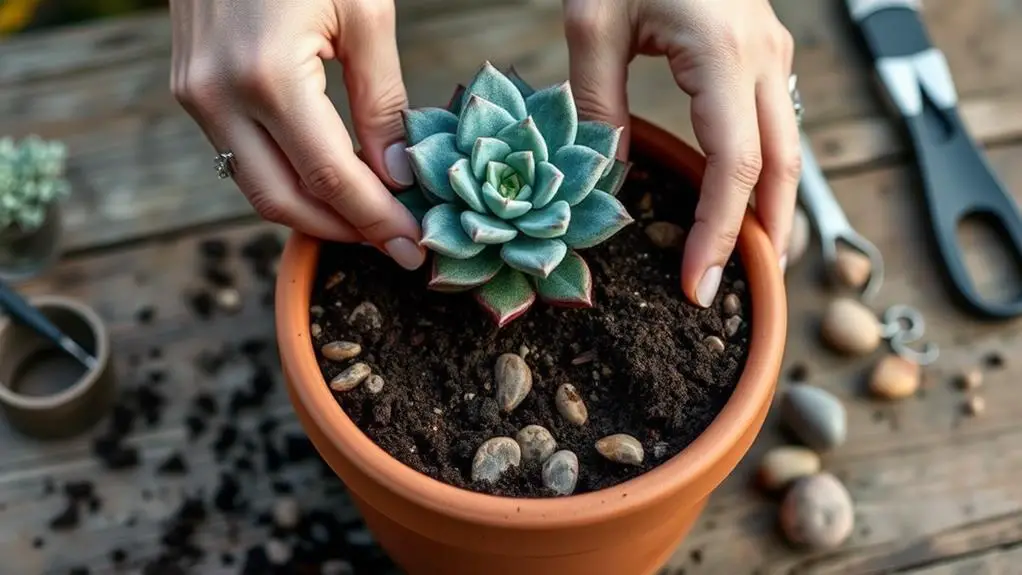
Sedeveria Blue Elf's vibrant health starts with the right soil and potting choices. Your plant thrives in a well-draining soil mix, which prevents root rot and guarantees healthy growth.
Combine potting soil, perlite, and coarse sand to create the perfect environment. This mix allows water to flow freely, avoiding waterlogged roots that can harm your succulent.
When selecting a pot, choose one with drainage holes. These holes are vital for letting excess moisture escape, which is essential for the health of Sedeveria Blue Elf.
Pay attention to the soil pH, aiming for a range between 6.0 and 7.0. This guarantees your plant can absorb nutrients effectively.
When it's time for repotting, pick a new pot that's one size larger and fill it with fresh, well-draining soil. Avoid watering for the first week to let the roots adjust to their new home.
Adding organic matter like compost can improve moisture retention while still maintaining good drainage.
Here are some key points to remember:
- Use well-draining soil to prevent root rot.
- Guarantee your pot has drainage holes.
- Mix potting soil, perlite, and coarse sand.
- Maintain a soil pH between 6.0 and 7.0.
- Incorporate organic matter for moisture retention.
Fertilization Tips
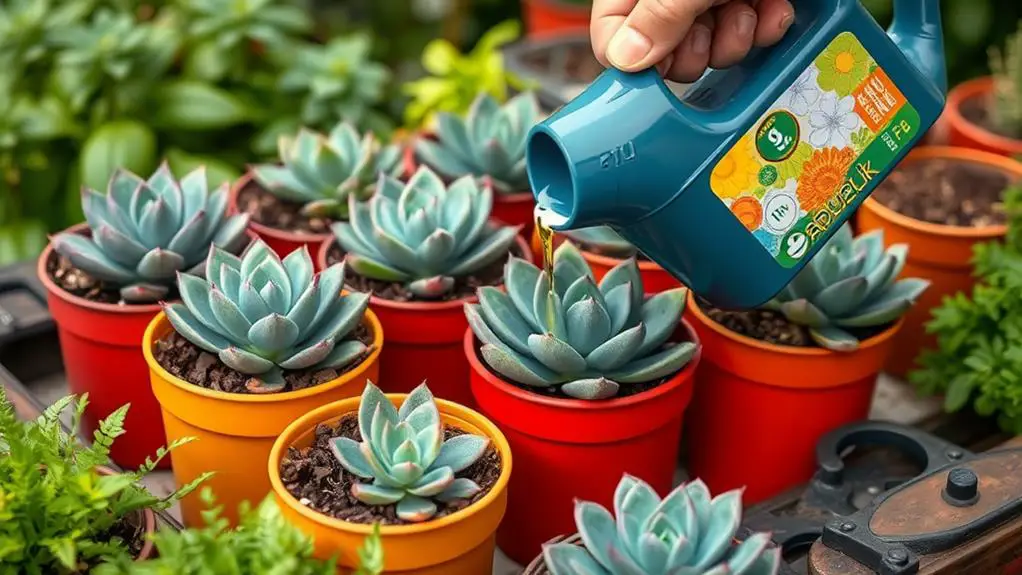
Caring for Sedeveria Blue Elf doesn't stop at soil and potting; feeding your plant the right nutrients is equally important. Fertilization plays a vital role in keeping your Blue Elf healthy and vibrant. During the growing season, which is typically spring and summer, you should fertilize once a month with a diluted, balanced formula. This promotes healthy growth without the risk of root burn.
Monthly Fertilization Guide
| Month | Fertilization Frequency | Soil Condition |
|---|---|---|
| Spring | Once a month | Moist soil |
| Summer | Once a month | Moist soil |
| Winter | Reduce frequency | Check soil moisture |
Using organic fertilizers is a great way to enhance growth without harmful chemical buildup. Always apply fertilizer to moist soil to prevent potential root damage. Fertilizing dry soil can cause root burn, which you definitely want to avoid.
Before fertilizing, check the soil moisture to confirm it's not overwatered or underwatered. Stress from improper watering can hinder nutrient absorption. During the winter months, when your plant's growth slows down, reduce the fertilization frequency. Proper care during these times will keep your Sedeveria Blue Elf thriving all year round.
Pruning Techniques

Pruning your Sedeveria Blue Elf in late winter or early spring is essential for promoting healthy growth.
Use clean, sharp scissors to carefully remove any dead or damaged leaves, making sure to cut cleanly to avoid harming the plant.
Regular pruning helps improve airflow, reducing the risk of pests and diseases, so keep an eye on your plant and adjust your care as needed.
Timing and Tools
Before new growth begins in late winter or early spring, it's essential to prune your Sedeveria Blue Elf to promote healthy development. Proper timing guarantees your plant is ready to burst into life with the best possible start.
You'll need clean, sharp scissors to make precise cuts, minimizing damage to your succulent.
Start by removing any dead or damaged leaves. This not only improves airflow around the plant but also reduces the risk of pests and diseases.
Regularly inspect your Sedeveria Blue Elf for any signs of stress or infestations. Promptly pruning affected areas helps maintain overall plant health.
Don't forget to sanitize your pruning tools between cuts to prevent spreading potential pathogens or diseases.
Here are some key points to remember:
- Timing: Prune in late winter or early spring before new growth starts.
- Tools: Use clean, sharp scissors for precise cuts.
- Remove dead leaves: This improves airflow and reduces pest risk.
- Inspect regularly: Look for stress or pest signs and prune affected areas promptly.
- Sanitize tools: Clean your tools between cuts to prevent disease spread.
Technique and Tips
To get the best results when pruning your Sedeveria Blue Elf, start by identifying the leaves that need to be removed. Look for dead or damaged leaves first, as they can hinder your plant's healthy development. Using clean, sharp scissors, carefully snip these leaves away to improve airflow and promote ideal health.
Next, remember to prune Sedeveria Blue Elf in late winter or early spring, just before new growth begins. This timing helps your plant recover quickly and encourages new, vigorous growth.
While pruning, be sure to inspect the plant for pests or signs of stress. Early detection can prevent more serious problems down the line.
It's essential to avoid over-pruning. Removing too many leaves at once can stress the plant and stunt its growth. A gentle approach will keep your plant thriving.
Once you're done, monitor the plant's health closely. Provide adequate light and water to support its recovery.
Ensure your Sedeveria Blue Elf is in well-draining soil, as this helps prevent root rot and other issues.
With the right care for Sedeveria Blue, you'll enjoy a healthy, beautiful plant. Happy gardening!
Propagation Methods

Propagating Sedeveria Blue Elf can be an enjoyable and rewarding process, allowing you to expand your collection with minimal effort. There are two main methods for propagation: leaf cuttings and offsets.
For leaf cuttings, select healthy leaves and let the cut end callus for a few days. Once callused, place them on well-draining soil and keep it lightly moist to promote root growth.
Offsets can be removed once they're one-third to half the size of the parent plant, guaranteeing they've roots attached. Replant these in fresh soil for successful propagation.
Both methods require bright indirect sunlight to encourage growth and root development. Using a well-draining soil mix is essential. A combination of potting soil, perlite, and coarse sand works best. This mix helps prevent rot and provides an ideal environment for rooting.
Propagation is most effective during the growing season (spring and summer) when the plant is most active.
- Select healthy leaves for cuttings.
- Allow leaf cuttings to callus before planting.
- Keep soil lightly moist to encourage rooting.
- Confirm offsets have roots before replanting.
- Use bright indirect sunlight and a well-draining soil mix.
Common Problems
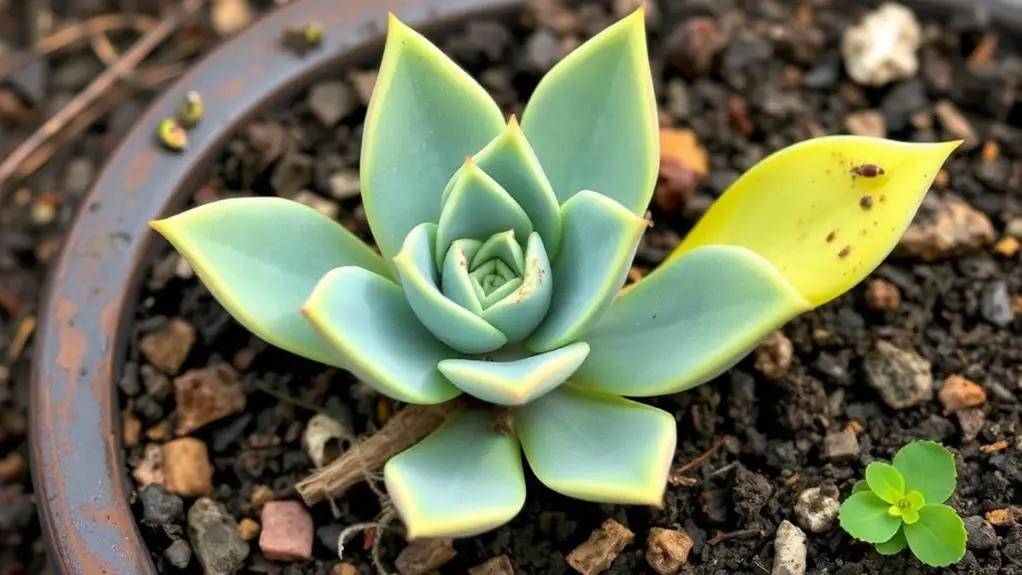
Caring for Sedeveria Blue Elf can come with its share of challenges, particularly when you encounter common problems like overwatering and pests. Overwatering is one of the biggest issues. It leads to root rot and fungal diseases. It's vital to let the soil dry out completely between waterings. Using well-draining soil can help prevent water from sitting at the roots.
Pests like mealybugs, aphids, and spider mites can also be a problem. Regular inspections and treatments with neem oil or insecticidal soap are essential to keeping these pests at bay. If you notice yellowing leaves, it might be due to overwatering. On the other hand, stunted growth could mean your plant needs more bright light.
Sunburn is another concern. Too much direct sunlight can cause brown or yellow spots on the leaves. Aim for bright, indirect light to avoid this. High humidity levels can make root rot worse, so maintain good air circulation around your plant.
| Common Problem | Solution |
|---|---|
| Overwatering | Let soil dry out, use well-draining soil |
| Pests | Inspect regularly, use neem oil or soap |
| Sunburn | Provide bright, indirect light |
| Yellowing Leaves | Check watering habits |
| High Humidity | Maintain good air circulation |
Frequently Asked Questions
How Do You Take Care of a Blue Elf Plant?
Place your Blue Elf in bright, indirect sunlight for at least 6 hours daily. Water it every 2-3 weeks, letting the soil dry out completely. Use well-draining soil, fertilize monthly, and check for pests regularly.
How Do You Care for a Sedeveria Blue Giant Succulent?
You should place your Sedeveria Blue Giant in bright light, water infrequently, and let the soil dry out completely between sessions. Use well-draining soil, fertilize monthly, and monitor for pests to guarantee healthy growth.
How Do You Care for a Sedeveria Succulent?
You should place your Sedeveria in bright, indirect sunlight for at least 6 hours daily. Water it every 2-3 weeks, allowing the soil to dry completely. Use well-draining soil, fertilize monthly, and monitor for pests.
How Do You Propagate Sedeveria Blue Elf?
To propagate Sedeveria Blue Elf, select healthy leaves, let them callus for a few days, and place them in well-draining soil. Keep the soil lightly moist. Alternatively, separate offsets from the parent plant and plant them directly.
Conclusion
Caring for your Sedeveria Blue Elf doesn't have to be hard. Just remember the basics: give it bright, indirect sunlight, water it infrequently but thoroughly, and use well-draining soil. Don't forget to fertilize monthly during the growing season and prune in late winter or early spring. If you spot any issues, like overwatering or pests, address them quickly. By following these steps, you'll keep your plant happy and healthy. You've got this!


